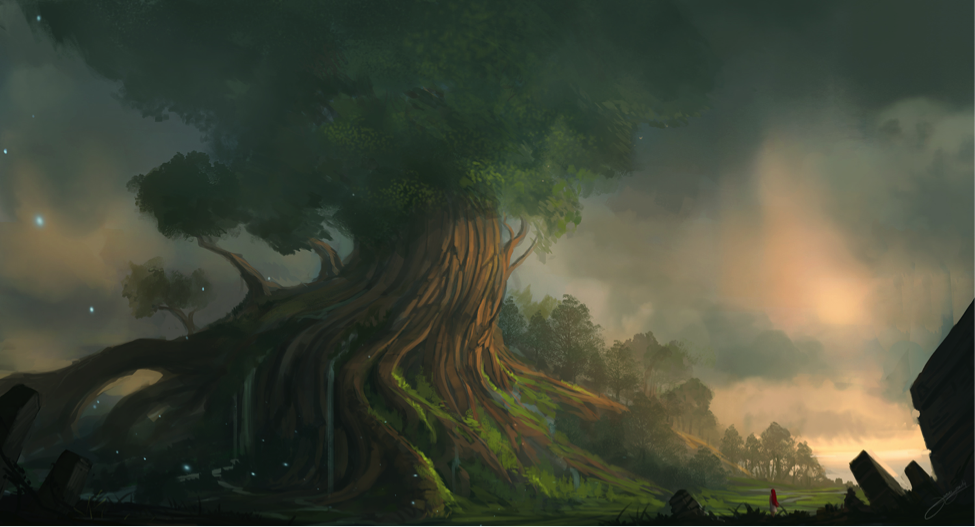
In my novel, “The Children of the Forest,” there is arguably no aspect of the story more important than Dearean’s environment. When first started working on my novel, I was driven to tell a story steeped in social-commentary that reflected the environmental woes plaguing our own world. I wanted my book to reflect the intense, eco-political conflicts of our world, but I needed a way to tie this idea into a fantasy setting. Leafing through dozens of old mythology books, I found my answer in an old drawing from Norse myth-
I stumbled onto a picture of the Tree of Life as depicted in Norse lore, and quickly became enamored with the symbol of life and magic, personified within the he shape of a tree of unparalleled size and scope. I decided the World Tree would be the focal point for my story, and thus “The Children of the Forest” was born.

Yggdrassil towers over the world.
Anchored by the Tree of Life – Yggdrassil – standing at its center, Dearean is an archipelago home to a variety of diverse races, sprawling kingdoms, and ancient empires. These various forces clash for control of the limited resources spread across the land, none more valued than that which is known as “manna.”
Manna is a magical force extracted from the very elements of the earth. Although manna can be withdrawn from small wells deep below the ground, or else taken from the sap of Yggdrassil, manna is most abundant within life forms known as “spirits.”” Along with a multitude of humanoid species, Dearean is also home to a vast collection of these (normally incorporeal) entities. Spirits are living vessels, filled with manna, and directly tied to the health of the land. The more spirits that inhabit a forest or a river, the more fertile and healthy that land beomes. Spirits are also directly tied to magic and its use within the world of Dearean.
 Silas Des’tra is one such sorceress.
Silas Des’tra is one such sorceress.
A single spirit, if captured, can provide enough manna to sustain an individual for some time, though this leads to quite the dilemma. A spirit is a living form of manna, or else a being born from where manna is found. Because manna is itself a part of the earth, the removal of spirits negatively impacts the land from which they are taken. By removing too many spirits from an environment the land is irreversibly damaged, quite possibly forever.
Alethia, a land of sprawling mountains and frozen wastes, far to the north of Dearean, is evidence of what horrors can befall those too blinded by their lust for power. Long ago, Alethia’s rulers sought to pull great quantities of spirits from their land to power the evil machinations of their sorcerers. Though this was successful for a time, the eventual imbalance of the land caused by the direct removal of so many spirits, led to the nearly total ecological collapse of Alethia. The “Dead-Kingdom,” as some refer to it now, serves as a chilling (pun intended) reminder of the dark fate that might befall any whom might seek to overturn the natural order.
Again, we see environment playing a direct role in the story. Alethia’s decay pushes its populace to commit further acts of aggression against their neighbors as their own territories no longer provide the sustenance for their to survive. The story is constantly focused on the direct relationship between civilizations and the lands they occupy.
 Spirits of the forest manifest themselves in different forms, though normally their shape reflects their natural environment.
Spirits of the forest manifest themselves in different forms, though normally their shape reflects their natural environment.
The demand for manna fuels the primary conflict of “The Children of the Forest.” Instead of a battle of ultimate good and evil, the novel’s protagonists as well as its antagonists are instead concerned with survival – itself only guaranteed through control of manna – this again reflects on the murkier aspects of real-world environmentalism, and it’s supporters and detractors. The conflict that stems from this is (in my opinion) far more fascinating than mere dark lords or heroes chosen by fate to thwart evil. It’s more believable, as relatable. Because the need to live and thrive is a notion anyone can relate to, it allows the reader to sympathize not just with one side or the other but instead with all sides.
How else can the environment affect the world(s) of our stories? It can shape cultures, religions, or lead to the rise and fall of empires and kingdoms. Do you have other examples of stories that focused on ecological unrest? Sound off in the comments below, and look for more great articles about our environment and how it shapes us over the coming weeks!
##
 Byron Gillan is an avid reader, recent college graduate, and freelance writer, with multiple publications in various newspapers, magazines, and online publications, including work for the Buffalo News. His first novel, The Children of the Forest, is now in production with the Quill imprint through Inkshares.com.
Byron Gillan is an avid reader, recent college graduate, and freelance writer, with multiple publications in various newspapers, magazines, and online publications, including work for the Buffalo News. His first novel, The Children of the Forest, is now in production with the Quill imprint through Inkshares.com.

